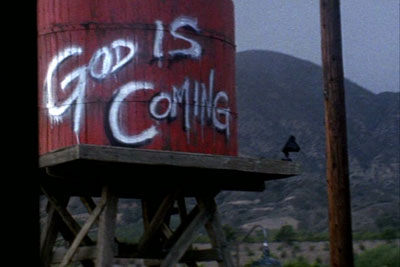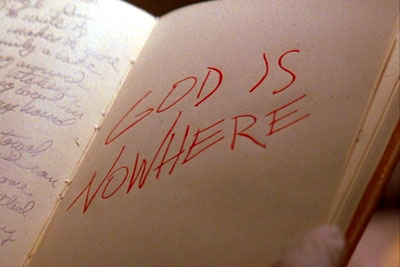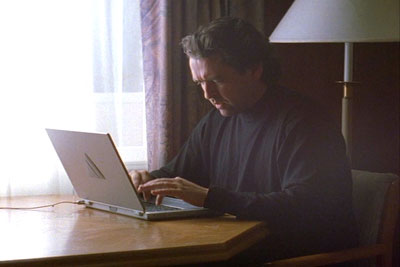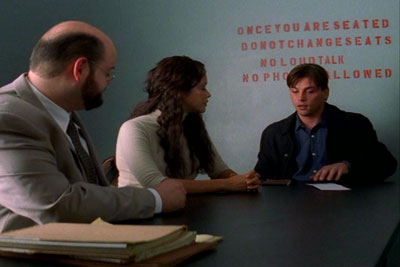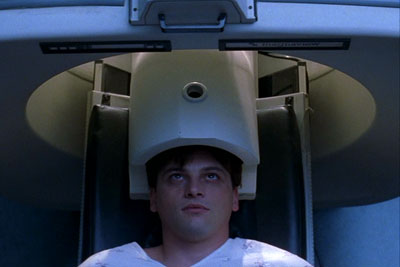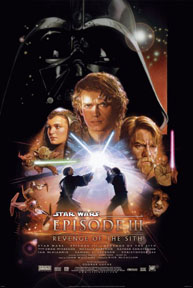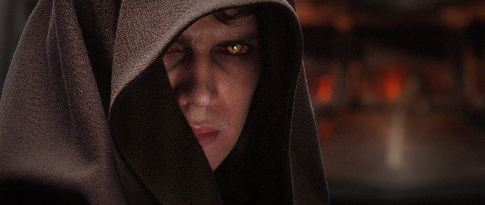 Welcome
Welcome
to Videodrome. I try not to set goals, but if I did, and if Devin won’t
sabotage me with his commie psychic ray, this should resemble a weekly column
that supports the cool stuff Dave does in the Underground by focusing on
directors and small groups of related films that Chud might otherwise miss.
Strangely enough, psychic rays are a large part of this first installment…maybe
the bearded liberal is already undermining me.
Eventually,
this will be less about reviews and more interested in pointing out all the
unbelievable stuff that’s now commonly available thanks to DVD. New is OK, but
older is great. To begin I want to go back a few years to Japan, from
1988 to 1996.

Cyberpunk’s Not Dead
The Matrix killed cyberpunk for me. Even
worse, it did the job in a way the genre would admire: by mutating it into
something that was almost recognizably ‘cyberpunk’, yet totally different.
Bigger, harder to control, and sadly much less useful. Granted, the term was
always pretty lame. William Gibson has tried his damndest to preserve a
literary notion of the genre, but for most people it’s just The
Matrix. Mention that Rubber’s Lover is cyberpunk, and
they’re going to expect something shiny and high-minded.
To me,
cyberpunk is forever dirty, street-level sci-fi. The word ‘punk’ ain’t in there
for nothing. It’s the passion of the Sex Pistols or Bad Brains, where it’s not
enough that the people in the songs are desperate. The music, and these films,
wouldn’t work if they didn’t use that same energy to push back at the audience.
And
all-important, buried in the grit was always the question: ‘What would you do
to transform yourself?’ That question, of course, is as fitting in the
Videodrome mindset as it is in the three films I recently watched: Tetsuo
The Iron Man, Pinocchio √964
and Rubber’s
Lover. All of these movies are fitting tributes to the idea behind Videodrome,
so they’re a pretty good way to kick off the column.
Whenever
you’re mutating into something glistening and new, a proper foundation always
helps. So I’ll kick off with a revisitation of the landmark flick that some
love to copy ande few have actually seen…
Tetsuo The Iron Man
(1988, Japan, Shinya
Tsukamoto)
 Specifically,
Specifically,
there are a couple of reasons I’m beginning here. First, the two Fukui films that follow
borrow so heavily from Tetsuo that it’s pointless to
discuss them without mentioning Shinya Tsukamoto’s pioneering film. Second is
that it had been at least ten years since I’d seen the film, and it was high
time for a refresher course. Finally, I see dismissals all over the internet
written by lazy-ass commentators who proclaim it to be impenetrable trash.
Balls. Tetsuo is overbearing and off-putting, but not difficult to
follow, as long as you’re paying attention.
Tetsuo also brings in the Davids, Lynch
and Cronenberg, both of whom are acknowledged by Tsukamoto. Setting aside the
obvious ‘body horror’ component — which I’d say is symptomatic of what’s
really going on in the film — Tetsuo looks a lot like Japan’s answer to Eraserhead.
The general aesthetic, the sound design and starkly interior nature of the real
story are all a contract-print reproduction of Lynch’s debut.
The film
lives in decaying urban spaces. A man, ultimately identified in the credits as
‘metal fetishist’, cuts a large slit in his leg, into which he slides a long,
threaded rod of metal. Images of famous runners adorn his workspace, which make
his transformative desires pretty clear: could this process bestow a new speed
and power? It’s just as obvious that something has gone wrong when the photos
all erupt in flashes of fire. In case it’s not obvious enough, however, we see the wound
crawling with maggots desperate to consume the decaying flesh.
The bolt, we discover, was infected with rust. Try to stop that pernicious orange virus. Staggering into the street, the
fetishist is struck by a car. The salaryman behind the wheel, terrified by the
consequences of his action, drags the wounded man off to the woods, where the
victim slips from consciousness as the salaryman and his girlfriend work out
their desires for hot tree sex. You’ve got to wonder how much free will the
driver really had, since his car seems to have tattooed ‘New World’ on it’s
metal grille.
And
that’s where everything breaks.
Back
home, the salaryman is infected by a sliver of metal from his shaver, a
stainless steel injection. The metal which took over the fetishist, that urban
spirit, now begins to control the salaryman as well. He quickly undergoes one
metamorphosis after the other, quickly outpacing The Guyver in the ‘most
uncomfortable costume’ race. On the other side of town, the fetishist lives,
and he races to face the salaryman in a lustful battle royale. The scorecard
says: unclean infection versus pristine transformation. It’s better than When
Godzilla Attacks!
But like
I said, the method of transformation is only indicative of the underlying idea.
Sure, it’s important that it’s metal; how better for the urban landscape to
rape mankind? Only concrete would be more effective, but it’s so inflexible.
The real
battle is between the willingly transformed (fetishist) and unwilling
(salaryman). It’s tragic in a way, because the fetishist desperately wants to
become something else, but he’s blown it. His adversary, on the other hand, has
an almost unhealthy lust for human life (and tree sex) and fights the
inevitable with all his will. Their battle is a half-hour chase scene through
the back streets of Tokyo.
Finally, there’s a sort of compromise that promises the metal that ‘new world’
it so desires.
(Miike
did his own transformation of this ending for Dead Or Alive: Final.
Shinya Tsukamoto himself appears in Ichi and DOA 2: Birds.)
It’s easy
to just get caught up in the spectacle of the conflict. Tsukamoto barrages us
with images that are sickly and revolting — rotting flesh, the penis drill,
strap-on tentacles — but he does it in a way that’s impossible to look away
from. It’s hyper-kinetic stop motion swirled through the lens in high contrast
black and white. He almost hyperventilates this film (it runs a mere 67
minutes) and even the flashbacks, which imply that the metal’s memory is
television, offer a tense but swift fascination.
Chu
Ishikawa bangs out an aural equivalent to the harsh landscape, channeling
Einsturzende Neubauten and Big Black into a set of songs that become the
movie’s mechanical pulse. But then he drops into a ’50’s milkshake dance number
whenever the film’s automobile hero hits the stage, equating the love and
enmity for metal with a crazy Norman Rockwell puppy love.
In the
years after Tetsuo, the film’s content was echoed in legions of followers.
Some were obvious (the Raimi-esque follow-up Tetsuo II: Body Hammer)
while others essentially returned Tsukamoto’s affections — take another look
at James Spader riding Roseanna Arquette’s leg in Crash.
But more
immediately in the film’s wake was a kinetic pair of films from Shozin Fukui,
and they’re up next.
(Tetsuo
is tragically out of print in the states, though DiabolikDVD.com
and other importers carry a legit Region2 PAL disc.)
Pinocchio √964
(1991,
Japan, Shozin Fukui)
 Fast
Fast
forward three years. While Tsukamoto was making Tetsuo, Shozin Fukui was
cutting his teeth shooting documentaries and musical performances. He was also
nurturing ideas for a film that could explore a different kind of
transformation: the evolution of the mind through the pressure of physical
pain. He evidently took the structure and style of Tetsuo as a mandate,
because this story of a displaced sex android is like that film’s awkward
younger brother.
Pinocchio
(who I’ll just call 964 from now on) is the android in question, an object cast
onto the street by an unsatisfied client. Built (or grown) solely to pleasure
others, 964 has no memory and no sense of the outside world. Wandering the
city, he meets Himiko, herself an amnesiac who seems to recognize something
about the poor guy, and quickly befriends him. As 964’s creator sends out a
search party, the robot and Himiko ultimately get down in ways only a sex robot
and amnesiac girl can.
And
that’s where everything breaks.
The
android’s creator says that the only way to free people is with a big jolt of
sex, and that’s exactly what happens. After a little lovin’, 964 is wracked by
incredible pain, which seems to be the result of his sudden understanding of
his own condition. He’s no longer a walking vibrator, but a shell of a man,
horribly aware of his backwards evolutionary step.
Whether
through the sex or 964’s subsequent power, Himiko is also unhinged, and
violently so. She’s been repressing memories of her own, which imply some role
in 964’s creation. And once the flood gates open, there’s no closing them.
Himiko
staggers through the subway, vomiting profusely. I might suggest to an
Alzheimer’s research panel that excessive vomiting, followed by rolling in the
result and, er, eating it, might help with memory loss…but then again that’s
probably not a good idea. Just try to tell Himiko that.
But as in
Tetsuo,
the fluids and kinetic movement are flashy ways of making a point. Trouble is, Fukui isn’t all that
clear about his intent. Rather than following the ‘pain to power’ thesis, he
establishes 964 and Himiko as a massively dysfunctional couple. First she helps
create him through a sickeningly violent process, then turns him into her own
slave, alternately caring and dispensing abuse. There is a final bizarre
physical transformation, but it’s a manifestation of that relationship, rather
than of a pure will to power fantasy.
Fukui tries to use the same stylistic
camera and narrative style that worked so well for Tsukamoto, but simply
doesn’t have the skill to pull it off. That really limits the film, and the
experimental narrative sags. His camera moves excessively to hide a limited
budget, and Fukui
only occasionally shoehorns meaning into the jarring movement.
Even with
those issues, there’s one overriding flaw that keeps Pinocchio from being as
unsettling and effective as Tetsuo: it’s too damn long. Fukui imitates the mad dashes through Tokyo that worked so well for his
inspiration, but he indulges himself both at greater length and slower pace. At
almost 100 minutes this is too long by half an hour.
There are
some really fun and intriguing ideas here, though. Before Bishop was revealed
as the creator of his own line of androids, 964’s morally dubious creator seems
to be making sex dolls in his own image. And I’m really interested in the
intersection of violence and memory, and how the result affects one’s ability
to relate to anyone else. That’s a huge part of the subtext here, but it almost
seems to be unintentional, making it almost too ‘sub’ to work.
There’s
also some fun humor — I love Himiko taunting the android’s pursuers, as well
as the final sequence when 964 takes hold of his own power. I certainly
wouldn’t blame anyone for completely missing Pinocchio‘s point,
however, which is just a forthright way of establishing my own critical escape
route when it’s revealed that this is actually a Heimlich Maneuver
instructional film. If you want vomit, you got it.
(Buy
it here from Amazon.)
Rubber’s Lover
(1996,
Japan, Shozin Fukui)
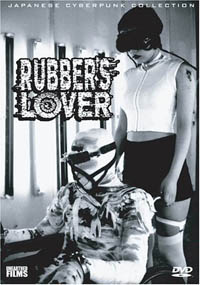 In
In
response, this film is for anyone who thought Pinocchio √964 was good
in theory, but too long, too scattered, or simply too thin. Fukui’s back on the
‘psychic power through physical pain’ trip, but he articulates it with far more
skill. Here his images are even more reminiscent of Tetsuo and Videodrome,
but this also feels more like a whole film, rather than an idea stretched too
far.
A trio of
scientists have been working for one of those classic shadowy organizations,
performing experiments to unlock the secrets of the mind. (Cue theremin,
please.) Shimika is the loner, and he thinks the drug ether is the key. The
remaining pair, Motomiya and Hitotsubashi, have been experimenting with a device
called the Digital Direct Drive, which bombards a subject with aural and visual
stimuli, essentially torturing the poor bastard until (a) he unleashes a wave
of psychic energy or (b) his head explodes. Option A doesn’t seem to happen
very often. In fact, neither technique
has a survival rate above .000.
And time
is running out for all three. Their corporate master sends a sexy lackey,
Akari, over to terminate their funding. Not such a good idea, since Motomiya
has been behaving erratically, and Shimika is addicted to ether, perhaps on his
way to becoming his own successful guinea pig. The lackey arrives as Motomiya
has decided to take matters, and the fate of Shimika, into his own hands.
And
that’s where (all together now) everything breaks.
Pumped
full of ether, wrapped in rubber (which provokes shock by depriving the body of
oxygen) and bombarded with evidence of his own violent past, Shimika
essentially becomes a scanner. The ether overload channels the power outward —
without the drug, the waves roll around in the skull and his head threatens to
go the way of so many others before it. The ‘power through pain’ concept
finally comes to a real fruition, and Shimika becomes the only one in all three
of these films to really achieve some sort of real evolution, even if the
effect is ultimately short-lived.
Whatever
experience Fukui gained between Pinocchio and this film was
invaluable, because he’s far more in control of the camera. The grainy black
and white creates scenes with a ridiculously uncomfortable atmosphere, and the
effects are more cleverly shot. And where his last film had screaming maniacs
instead of characters, here Fukui creates some immediately recognizable
personalities, most of which he uses well. I was scared for, and of, Shimika,
and even enticed by the oppressive eroticism between Akari and the scientists
female assistant.
This
isn’t a real finale for the cyberpunk barrage that began with Tetsuo,
but it is an effective summation. The technology on hand is essentially common,
and the scenes of bombardment by the Direct Digital Drive are powerful even
though the basic image of a guy with his head stuck in a TV has become debased
currency. Fukui belives in it, and that’s what makes this film work, and in
fact what makes the whole genre. There’s no irony here, but an inkling that we
might be relying on the wrong things, and fascination mixed with a genuine
terror of the consequences.
Finally,
one constant in all three films is that, during the process of transformation,
violence is not only done to the characters, but perpetrated by them as well.
It’s a bleak and horrifying worldview. That’s where a lot of the desperation
comes in — I don’t know if it’s a perversion or ratification of the punk ethos
— since the final effect can only be realized by savaging those around you. If
that’s the case, maybe it was inevitable that a cyberpunk savior like Neo would
show up to make us all feel better. Or not.
(Buy
Rubber’s
Lover here from Amazon. Considering the 16mm source, Unearthed
Films has done a great job with both of these Fukui films, each of which looks
and sounds as good as can be expected from such cyberpunk curios. Special
mention has to go to the menu design, which I really enjoyed.)

Thanks
for checking out the first column. As always, if you’ve got comments (derisive
or supportive) shoot ’em over to russ @ theporkstore.org. I check facts pretty
thoroughly, but with foreign films and smaller stuff misinformation abounds. So
if you notice any small inaccuracy or outright lies, please let me know. If
there are pairs or trios of films, mini-movements or specific filmmakers that
Chud really needs to stroke, make yourself heard. Future installments will
feature more festival coverage, express love for a couple of my favorite
character actors (Warren Oates and Don McKellar) and I’ll hit the output of
filmmakers like Lars von Trier, Yasujiro Ozu and, when I’m feeling mighty and
capable, Luis Bunuel. That might take a couple of installments.
Generally,
I’ll keep the content limited to movies that are in print in North America on
DVD, though at times I’ll have to range further abroad or even (gasp!)
encourage some VHS rentals.
Next week
will be dedicated to Wong Kar-Wai’s pair of Hong Kong love stories, 2046 and
In
The Mood For Love. After that will be a Chud exclusive look at the DVD
restoration of the oddball animated film Rock And Rule. I went to Boston last
month to check out the process and can’t wait to talk about it.
Discuss this column right here on our message boards.

 BUY IT AT AMAZON: CLICK HERE!
BUY IT AT AMAZON: CLICK HERE!
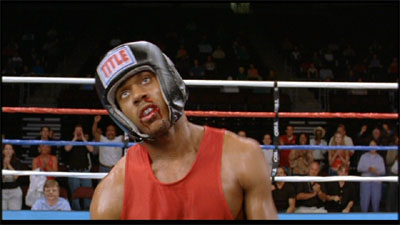
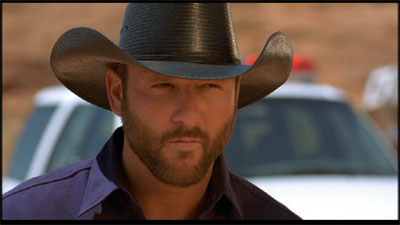


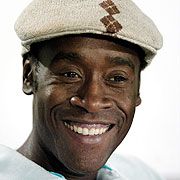 Universal has already sunk lots of money into the film American Gangster – both Denzel Washington and Benicio Del Toro had pay or play deals when they signed on to the film just before it imploded. That, of course, means that they got paid for doing diddly shit, which I am under the impression is a familiar situation for many of our daytime message board posters.
Universal has already sunk lots of money into the film American Gangster – both Denzel Washington and Benicio Del Toro had pay or play deals when they signed on to the film just before it imploded. That, of course, means that they got paid for doing diddly shit, which I am under the impression is a familiar situation for many of our daytime message board posters. Michelle Yeoh is a hot property in Hollywood this summer, as Mission: Impossible 3 and the Hannibal prequel are both looking to land the Asian lovely. She had been in talks with the M:I3 folks for a while, but it was while visiting the Cannes Film Festival that Yeoh was approached by the Hannibal crew.
Michelle Yeoh is a hot property in Hollywood this summer, as Mission: Impossible 3 and the Hannibal prequel are both looking to land the Asian lovely. She had been in talks with the M:I3 folks for a while, but it was while visiting the Cannes Film Festival that Yeoh was approached by the Hannibal crew. The website for the Sundance hit The Chumscrubber is online, and it’s worth checking out just for its amazingly impressive cast listing. They’ve got John Heard, William Fichtner, Carrie Ann Moss, Ralph Fiennes, Glenn Close, Allison Janney, Jamie Bell, Rita Wilson and the still-shamefully -cute-to-me-even -after-I-met-her-underage-self Camilla Belle.
The website for the Sundance hit The Chumscrubber is online, and it’s worth checking out just for its amazingly impressive cast listing. They’ve got John Heard, William Fichtner, Carrie Ann Moss, Ralph Fiennes, Glenn Close, Allison Janney, Jamie Bell, Rita Wilson and the still-shamefully -cute-to-me-even -after-I-met-her-underage-self Camilla Belle.






 Here’s some good news for fans of Shaun of the Dead: Nick Frost, who played Ed in that film, did a show in the UK called Danger! 50,000 Volts, and it’s finally coming to the US (Now somebody get Spaced over here. Not for me – I imported it from the UK. But for the rest of you. It’s amazing!). I am working out an interview with Nick sometime soon (my third with him – at this point I think I have to make him my firstborn’s godfather or something), and I hope to have a review of this set for you before it hits stores. In the meantime, here’s the press release – and pay special attention to the info on zombies…
Here’s some good news for fans of Shaun of the Dead: Nick Frost, who played Ed in that film, did a show in the UK called Danger! 50,000 Volts, and it’s finally coming to the US (Now somebody get Spaced over here. Not for me – I imported it from the UK. But for the rest of you. It’s amazing!). I am working out an interview with Nick sometime soon (my third with him – at this point I think I have to make him my firstborn’s godfather or something), and I hope to have a review of this set for you before it hits stores. In the meantime, here’s the press release – and pay special attention to the info on zombies… Welcome
Welcome
 Specifically,
Specifically, Fast
Fast In
In I approach my THUD duties with the best of intentions. I would like to have this column to you more often, but the honest truth is that it takes me multiple hours to put one of these together, and I don’t always have a solid block of time to give to the endeavour (thus the sporadic THUD Newsbreaks, keeping you informed between columns).
I approach my THUD duties with the best of intentions. I would like to have this column to you more often, but the honest truth is that it takes me multiple hours to put one of these together, and I don’t always have a solid block of time to give to the endeavour (thus the sporadic THUD Newsbreaks, keeping you informed between columns). 
 You can join the club at
You can join the club at  amount of money to tens of millions of dollars is that the people around you dramatically change.
amount of money to tens of millions of dollars is that the people around you dramatically change. Justin Timberlake is continuing his burgeoning acting career with a guest stint on what will probably be the final season of NBC’s Will and Grace. The former member of N’Sync and current holder of the sobriquet “The Trousersnake” will be playing gay – he’s going to be Jack’s bad boyfriend. Of course I know some people who tell me he wouldn’t be playing gay, but these are the same people who tell me that every single human being who has ever appeared in a movie or on television is homosexual. Not that there’s anything wrong with that.
Justin Timberlake is continuing his burgeoning acting career with a guest stint on what will probably be the final season of NBC’s Will and Grace. The former member of N’Sync and current holder of the sobriquet “The Trousersnake” will be playing gay – he’s going to be Jack’s bad boyfriend. Of course I know some people who tell me he wouldn’t be playing gay, but these are the same people who tell me that every single human being who has ever appeared in a movie or on television is homosexual. Not that there’s anything wrong with that.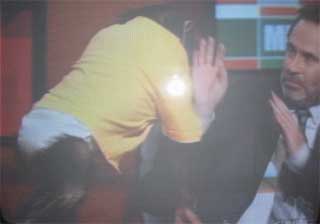 when Tim Robbins says something political – who wants to hear the politics of some stupid actor! – but they back the Millers and Schwarzeneggers of the world.
when Tim Robbins says something political – who wants to hear the politics of some stupid actor! – but they back the Millers and Schwarzeneggers of the world. more complex than people were expecting. But it’s that complexity that I love; while I like the formulaic aspects of the other L&O shows, there’s something about the wheeling and dealing behind the scenes of a trial that I just think is cool. It’s also possible that this show was portraying law enforcement and the justice system a little less black and white than the other L&O shows.
more complex than people were expecting. But it’s that complexity that I love; while I like the formulaic aspects of the other L&O shows, there’s something about the wheeling and dealing behind the scenes of a trial that I just think is cool. It’s also possible that this show was portraying law enforcement and the justice system a little less black and white than the other L&O shows. and things. I think the show will be a little bit different because of it, but Jennifer is so excited about everything right now…"
and things. I think the show will be a little bit different because of it, but Jennifer is so excited about everything right now…" To make matters worse, Moore has left LivePlanet, the production company behind Greenlight, to start his own company.
To make matters worse, Moore has left LivePlanet, the production company behind Greenlight, to start his own company. 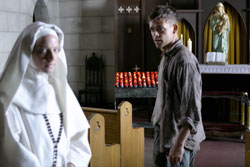 bigwigs think that the show is a ponderous waste of effort for both creators and fans, filled with faux imagery and meaning solely to trick people into thinking that something is going on.
bigwigs think that the show is a ponderous waste of effort for both creators and fans, filled with faux imagery and meaning solely to trick people into thinking that something is going on.
